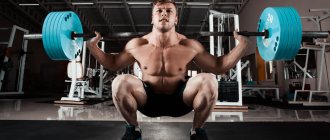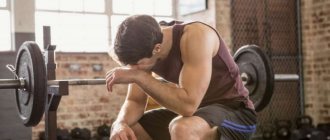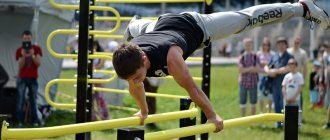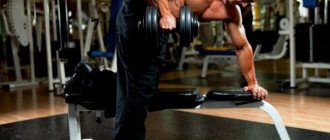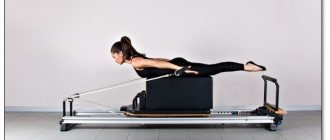In this material we will try to list the main types of physical activity with a brief description of their features.
The material is intended for those who are just beginning to understand the specifics of sports physiology. It is clear that the effect of physical activity on the body is determined by a whole set of factors - amplitude, speed (intensity) of movement, the presence or absence of weights, the number and size of muscle groups involved. Let's look at the main types of physical activity.
Static or eccentric load
An eccentric movement is a movement in which the muscle does not contract, but rather lengthens. These are usually resistance exercises or the negative phase of the movement. For example, when bending the biceps with a barbell, the muscle contracts, and when extending the arms (reverse phase) with the same barbell, there is a static load.
Static load is a physical exercise that fixes the position of the body under load without making any movement.
EXAMPLES OF EXERCISES:
Static poses performed with effort: yoga poses, planks of all types, stances in martial arts, reverse movements with a barbell (with an emphasis on reverse phases), rock climbing, bouldering, etc.
IMPORTANT:
- It should be noted that it is this type of physical activity that causes so-called muscle soreness - pain for 1-3 days after physical activity.
- The reverse phase of the movement can also be performed with a large number of repetitions, for example, exercises “descending stairs” can cause terrible soreness. Those who train on simulators or on a flat surface, and then go to trail running competitions, can fully appreciate this effect.
- Physical activity of a static and eccentric nature develops strength, but does not lead to a significant increase in muscle mass.
- The creatinine-phosphate reaction plays a major role in heavy exercise of this type - more about it below.
ADVICE. Include static and reverse exercises at least in the amount of 5-10% of your training time, regardless of the sport you are involved in (with the exception of marathons and very long activities).
Hypoxic loads
They are used to train endurance of professional athletes. Hypoxic loads are considered heavy exercises, as they are performed in conditions of lack of oxygen, when a person is at the limit of his capabilities.
The main goal of this type of training is to minimize the process of acclimatization of the body in an unfamiliar environment. Hypoxic exercises are used to train the respiratory system of climbers, who often live in high altitude conditions where thin air prevails.
Maximum Strength Development
Repetitions with large (75-100%) of the maximum possible weights for 1-5 times. Physical activity of this type is the basis for speed-strength sports - powerlifting and other types of weightlifting, rock climbing.
EXAMPLES OF EXERCISES. This training method is especially effective for large muscle groups and, accordingly, basic weightlifting exercises with large weights: squats with a barbell on the shoulders, deadlifts, bench presses, overhead pushes, bent-over barbell rows, barbell snatches for a set, etc.
IMPORTANT:
- The main mechanism for ensuring such sports loads is the fastest possible use of ATP in muscle fibers, in which creatine phosphate and creatine-phosphate reactions play a major role. Therefore, it makes sense to include this nutritional supplement in your diet during vigorous physical activity of this type, at least 1-3 grams immediately before training.
- Muscle growth during such physical activity will be noticeable (with a normal high-carbohydrate and high-protein diet), but much less than doing 8-16 repetitions with lighter weights. Strength training does not lead to weight gain. It seems that this type of training is relevant for mountaineers and rock climbers who periodically have to perform high-amplitude power movements.
- Large muscle groups require a long recovery period - at least 4 days between strength training sessions.
- Between approaches there should also be significant rest - 3-5 minutes. This is necessary so that the level of creatinine phosphate has time to recover
- It makes sense to include climbers and most athletes in training
The principle of choosing types of physical activity (according to the nature of the impact)
The correct choice of optimal exercises is the key to obtaining the desired result. That is why before starting training you need to clearly define the final goal. It could be:
- rehabilitation after injuries, operations and chronic diseases;
- healing and recuperation, relieving stress after a hard day’s work;
- maintaining the body in its current physical shape;
- increasing endurance and increasing body strength.
Selecting the load in the second and third options usually does not cause difficulties. But choosing exercises for therapeutic purposes on your own is much more difficult. When thinking about what types of physical activity are most effective for recovery, one should take into account the person’s current condition and capabilities.
The same exercise can be very effective for an athlete in moderate physical shape and absolutely useless for a beginning athlete. Therefore, the choice of training program should be carried out according to the principle of threshold loads, and it is better if the coach is well aware of the athlete’s condition and capabilities.
Skeletal muscle hypertrophy
Physical activity performed for 1-1.5 minutes. with weights that allow you to perform 8-16 repetitions. With proper nutrition, this is the most effective way to build muscle mass, which is especially actively used in bodybuilding. Another thing is that physical activity of this type is rarely found in everyday life and in sports other than bodybuilding, and there is no particular effect from the point of view of functionality from these exercises.
EXAMPLES OF EXERCISES: the entire modern bodybuilding system (the founder of which is Joe Weider - trainer of champions) with a variety of both basic (squats, presses, deadlifts with free weights) and isolated (along a given trajectory on simulators) physical exercises.
IMPORTANT:
- Physical activity of this type leads to stimulation of hormonal metabolism and the production primarily of testosterone, so after such training, well-being, mood, and desire to live improve, which is difficult to achieve, for example, when running a marathon.
- This is the easiest way to achieve an athletic build, but only with proper nutrition. Bodybuilders usually alternate periods of “bulking” and “cutting”, the nature of physical activity during which is radically different.
- These exercises can accelerate the pulse (Heart Rate, abbreviated HR) to 120-130 beats/min, the nature of the load is aerobic (without significant oxygen consumption)
- During the exercise, acidification of the body occurs when the production of lactate (lactic acid) in the muscles exceeds its consumption - the athlete feels a burning sensation in the muscles and general fatigue
Intensity and volume of training in bodybuilding
Thanks to the intensity and volume of training, the athlete can objectively evaluate his results and control the training process without crossing the line of overtraining.
To put it simply, the athlete needs to know what average weight was used and how many kilograms were lifted during the session. For example, you performed an exercise in warm-up sets with a weight of 60 kilograms, performing 12 repetitions. For the third set, the weight was increased to 80 kilograms and the number of repetitions was reduced to 10. In the fourth set, you worked with 100 kilograms for 8 repetitions. The final approach was the fifth approach, in which the weight of the sports equipment was 120 kilograms with 6 repetitions. If you sum up the entire load over five sets, then the total training volume will be 3760 kilograms.
After this, you need to determine the average weight used during the exercise. To do this, divide the total volume by the number of repetitions in all sets. In our case, the average weight will be 78 kilograms. This will allow you to control the intensity of your workouts and make progress permanent.
Anaerobic functional load
It is generally accepted that the maximum heart rate can be considered a value equal to 220 - the age of the athlete. Those. if an athlete is 35, then his maximum heart rate = 220-35 = 185. Of course, everything depends on the level of adaptation to physical activity and individual characteristics, but for the entry level it is quite possible to accept this formula. There are a number of methods for determining heart rate max and ANNO (anaerobic threshold), but at the initial level the formula described above is quite sufficient.
Anaerobic (well, i.e. anaerobic-aerobic) is considered physical activity from cyclic exercises (one movement is performed many times, such as running) at a heart rate = 80-95% of the maximum heart rate. Approximately at a pulse of 170-175 beats/min.
The types of sports load described above are anaerobic, however, cyclic sports (when one movement is repeated many times - running, swimming, skating, cycling, speed skating) allow you to achieve anaerobic load when performed at high speed with a large amplitude.
EXAMPLES: speed running from 100 m to 3 km at a speed close to maximum, other cyclic loads lasting 0.5-15 minutes.
IMPORTANT:
- Loads of this type are difficult to perform and are not recommended for beginners;
- Physical activity at the anaerobic threshold requires a long recovery period between workouts; for amateur athletes this should be at least 2-4 days.
- This type of training “falls off” the fastest, so usually the emphasis on functional anaerobic physical activity is especially relevant in the pre-competition period. During periods of basic training, it is better to concentrate on aerobic exercise on the one hand, and on the strength base on the other.
Group of interval exercises: what are their features?
During training, athletes can alternate and combine different types of physical activity (and their intensity). In this case, they talk about interval load, when classes include elements of the first and second types.
For example, young and healthy men involved in strenuous sports are required to perform aerobic exercise. That is, during their training, heavy exercises and light running alternate. At the same time, track and field athletes can additionally use large loads affecting a specific muscle group. In sports, types of physical activity alternate constantly, especially when it comes to professional training.
Black hole in training
Physical activity, usually of the cyclic type, at a heart rate at a level of 75 to 85% of the maximum (conventionally from 150 to 170) is a “black hole” in training, i.e. essentially an ineffective waste of time. The fact is that with such a pulse, effective glycolytic metabolism is already activated (glycogen stored in the athlete’s muscles and liver is consumed), and fat consumption (the so-called lipid metabolism) is reduced, but at the same time this is not enough for full functional training. At the same time, the athlete’s feelings are as follows: on the one hand, he feels that he is “training”, on the other hand, he feels “tolerably hard.” That is why most inexperienced amateur athletes spend maximum of their time on this physical activity, and this is very ineffective in terms of results.
You need to either conduct long workouts at a lower heart rate, which will strengthen the capillary system and develop lipid metabolism, or, on the contrary, go to higher heart rate zones or strength physical activity.
Intensity of training in bodybuilding when gaining mass
To prevent muscles from adapting to the load, athletes need to vary the intensity of their activities. This approach to organizing the training process is called periodization. Maximum results can be achieved using the following scheme:
- 1 week - high-intensity training;
- Week 2 - classes with medium intensity;
- Week 3 - maximum high-intensity training;
- Week 4 intensity is low.
The main mistake most athletes make is keeping the intensity at approximately the same level each week.
By reducing the load every fourth week, athletes will be able to train more effectively during the remaining weeks. If you are not able to perform a certain action at the moment, it does not mean at all that it cannot be performed in the future. By using low-intensity weeks, where the muscles received significantly less workload, you will give them the opportunity to adapt to the loads received over the previous three weeks.
It should be remembered that in bodybuilding the training process is based precisely on the body’s ability to adapt to stimulating loads. However, it is impossible to stimulate adaptation and achieve it at the same time. These two processes can only occur sequentially.
When the load is reduced for a short period of time (one week), it is much easier for the muscles to adapt to the previous ones. It should also be remembered that strength gains increase after completing low-intensity training over the next week.
Aerobic cycling exercise
Aerobic physical activity up to a level of 65-70% of heart rate (+-130 beats/min) for average people and amateur athletes is considered easy and can be performed for a long time (more than an hour) - used by athletes for recovery and for beginners.
A load in the range of 70-75% of the maximum heart rate (+-140 beats/min) is most effective for the development of the aerobic base, i.e. the body's ability to perform physical activity with maximum oxygen consumption.
IMPORTANT:
- It makes sense to carry out this kind of cyclic training such as running, cycling, swimming in the aerobic range for more than 40 minutes, and preferably more than 1 hour, because... The longer the workout lasts, the greater the role lipid metabolism plays (energy supply due to the breakdown of fats, not glycogen).
- Again, to stimulate lipid metabolism and fat burning during training, it is not recommended to eat food either during or immediately before or after exercise.
- If we talk about nutritional supplements, then again, for the purpose of burning fat and stimulating the heart muscle, it makes sense to pay attention to L-carnitine.
- There are complex methods for determining the threshold of anaerobic metabolism and, accordingly, the pulse zone, but for beginners it is easy to determine aerobic physical activity - breathe freely through your nose. If this is difficult and impossible not to open your mouth, then you have left the desired zone (entered the black hole of training) and you need to slow down.
- This kind of long physical activity should be the basis during the basic periods of training, because endurance is trained for a long time and is maintained for a long time, and in the pre-competition and competitive periods, aerobic activity should take much more time.
How to evaluate the training load and its impact on the athlete’s body
[Total: 1 Average: 1/5]
To ensure that training plans are based on modern physiological concepts, objective and subjective indicators are now widely used to assess the level of performance and its changes under the influence of the training means used.
However, simply calculating parameters such as volume (measured in kilometers or hours) is not sufficient to describe the level of psychophysiological stress experienced by an athlete. Stress caused by sports training is determined by more complex dependencies - intensity, duration (volume) and frequency of training.
To establish the effectiveness of training in practice, as a rule, the method of compiling target functions that reflect the dose-effect relationship . Changes in the increase in the trained function depending on the volume of training loads performed reflect adaptive changes in the body that occur during the training process. The determinants of these processes, according to some authors, are biochemical changes, recovery rate, risk of injury, etc. Let's look at some approaches to measuring training load.
Training impulse method (TRIMPS).
The training impulse method (TRIMPS - Training Impuls) was developed by a group of foreign sports physiologists under the leadership of E.U. Banister. The method consists of measuring a training session in units - doses of physical effort.
Training Impulse Index (TRIMPS) – the magnitude of the training load – evaluates the load using the formula: TRIMP = T (mins) x ∆HR x Y
Where: T – load duration (min), ∆HR – heart rate, Y
– weighting coefficient of a given heart rate range.
The weighting coefficient “y” characterizes the average lactate profile and is equal to 1.67 for women and 1.92 for men. The use of this method is limited by the need to constantly use heart monitors during training. In addition, this technique cannot be used to quantify strength training or submaximal running loads. Based on the lactate profile, it is advisable to select individualized coefficients that characterize the relationship between heart rate and lactate concentration for a particular athlete. The same amount of TRIMPS can be obtained from a short, high-intensity workout as from a high volume of low-intensity training.
Method of generalized training zones.
A number of researchers have used the traditional five zones of training intensity, based on different heart rates. Each zone is assigned a weighting factor, and TRIMPS is calculated by multiplying the time spent in each training zone by the corresponding factor. Here is one example of the distribution of coefficients by pulse zones.
The limitations of this method include the fact that in different subjects the anaerobic threshold is characteristic of different heart rate levels. For example, for one athlete, the anaerobic threshold occurs at a heart rate of 76% of the maximum, and for another, the anaerobic threshold heart rate is 83%. Performing 30 minutes at 78% intensity will earn each person the same number of TRIMP points (30 x 3), but the physiological stress will vary significantly.
- The first zone is, as it is commonly called, the aerobic zone, which is at the level of the aerobic threshold and below. The upper limit of this zone is the first lactate threshold (LT1), which corresponds to a lactate concentration of 2 mmol/l. As a rule, it is in this intensity range that highly skilled athletes in endurance sports carry out most of the workload. Energy, when loaded in this zone, is extracted mainly through the oxidation of fatty acids. Athletes working in this zone develop the body's ability to effectively use fatty acids as an energy source, which increases their performance.
- The second zone, adjacent or mixed, is above the aerobic threshold (first ventilatory threshold), but below the anaerobic (second ventilatory threshold). Energy supply at this intensity is provided both through the oxidation of fatty acids and with a progressive increase in the oxidation of carbohydrates. In the intensity range of the second zone, the lactate concentration reaches a level of 2-4 mmol/l.
- The third zone lies in the interval between the level of the anaerobic threshold and the value of maximum oxygen consumption (MOC). The third zone is a zone of high-intensity physical activity, where the main source of energy is carbohydrates obtained through the breakdown of glycogen. Competitive activity is close in intensity to the third zone. For highly qualified professional athletes, about 20% of the entire training load occurs in the third zone.
- Supramaximal load lies outside the MPC value . At this intensity, the anaerobic mechanism of energy supply predominates. This intensity is close to the maximum possible, and can be maintained by the athlete for a relatively short time.
From a practical point of view, the above zones have fairly wide boundaries. In Norway, a country with a traditionally strong cycling discipline, it is customary to divide intensity zones in a more detailed manner, without losing the general outline of physiological principles. Their classification is dictated more by practical needs than by physiological justifications. According to the Norwegian scheme, the zone at and below the aerobic threshold is divided into two subzones 1 and 2, respectively.
- Zone number one is usually called recovery zone.
- Zone number two is called moderate. As a rule, long rolling-in training is carried out in the temperate zone.
- Zone number 3, the mixed zone, is light in intensity.
- Zones 4 and 5 lie above the anaerobic threshold and have narrow ranges. These zones are usually called the zone of medium and high severity.
- Anything above the intensity of the VO2max level is in the supramaximal zone, the anaerobic zone. With this intensity, accelerations of short duration are usually made and prolonged stay in this zone leads to fatigue or, in the worst case, overwork.
Classification of the severity of physical activity is necessary for a more accurate analysis of preparation and drawing conclusions. According to the famous sports specialist from Norway, Stephen Seiler, from the point of view of physiological reactions, only 3 intensity zones matter:
- to the aerobic threshold (the average athlete has a lactate concentration of 2 mlM/l)
- mixed zone (between aerobic threshold and anaerobic threshold, lactate 2-4 mlM/l).
- after the anaerobic threshold (lactate >4 mlM/l).
Each zone is assigned a coefficient (1,2,3, for example). The time spent in each zone (information is available in modern sports cardiomonitors - Polar, Garmin, Ciclosport, etc.) is multiplied by a coefficient and added together. This is the training load according to the modified generalized training zone method. Another name for the numerical training load estimates derived from the three zones is Lucia's TRIMPS.
The so-called “session-goal method”.
An alternative approach to measuring time spent in different intensity zones was proposed in the work of Norwegian specialist Stephan Seieler. Unlike the approach based on importing training data from sports cardiomonitors, in the training goal method each training session (or part of a session, for example, interval work, warm-up-cool-down) is assigned a corresponding number, based not on the actual accumulated time in the zone, but based on from the goal set by the trainer to conduct a training session or part of it in the target intensity zone. The comparative analysis carried out in this work showed that these two methods give different estimates of the time spent by the athlete in intensity zones. This is due, firstly, to the inertia in the response of the cardiovascular system to increasing intensity. Secondly, at submaximal speeds of short duration, heart rate ceases to be a valid measure of the degree of training stress experienced by the athlete.
A limitation of this basic and generalized training zone method is the use of a linear relationship between weighting coefficients and heart rate, which does not accurately reflect physiological responses at speeds higher than the anaerobic threshold. In addition, the selection of weighting coefficients is subjective. Finally, weighting coefficients characterize a certain range of intensities described by heart rate. Meanwhile, the load at the beginning of the zone and at the end of the zone are obviously associated with slightly different levels of physiological stress, but the magnitude of the measured training load will be the same.
At the same time, an increase in the average heart rate for a workout by one beat per minute can transfer the entire workout from one zone to another, higher one (and the workout time will receive a larger weighting factor). However, from a physiological point of view, these training loads are almost identical. .
A common drawback of all approaches using the training pulse technique is also the reduction of the training load to a single number, without regard to the energy system involved in performing the training or competitive work. For example, a 3K run at a low intensity might produce TRIMPS=15 for some athlete. The same number of TRIMPS as a competitive 1500m run. This method does not take into account the specific training effects associated with energy systems. Nevertheless, this group of methods has become widespread as the main method for measuring training and competitive load.
It should be noted that in real conditions of training and competitive activity, the use of traditional instrumental methods is associated with significant difficulties. Therefore, psychometric methods, which make it possible to integrally assess the loads performed, are attracting increasing interest from sports specialists. The assessment of an athlete's own efforts quite accurately reflects the individual perception of the intensity of the training load. This assessment can be expressed using numerical scales (Borg scale, RPE scale, “rate of perceived exertion”) .
As the use of this method has been shown in comparison with subjective assessments of physical activity, the use of a large volume of low-intensity loads in training practice underestimates the level of physiological stress using the generalized zone method in comparison with subjective assessments of RPE. Comparing athletes who spend a lot of time in high-intensity training regimes leads to an overestimation of the level of training load by methods using heart rate compared to quantification methods based on the use of subjective self-assessments.
At the same time, it should be taken into account that in Russian-language and foreign publications the terminology used differs significantly, which can lead to discrepancies. It seems that there is an urgent need to streamline and unify definitions in the field of sports science. An accurate understanding of the terms allows us to adequately assess the achievements in this special field of knowledge, while at the same time, the incorrect use of terms or the accumulation of unnecessary terms only removes us from reality and hinders the development of this discipline.
In the domestic literature devoted to the problem of quantifying training and competitive loads, the concept of “sports readiness” is widely used, which includes fitness, functional readiness, and sports form. In a broader sense, the structure of an athlete’s preparedness includes technical, physical, tactical and mental elements. At the same time, some experts emphasize that the mentioned conditions, although not synonymous, adequately reflect the course of adaptive processes to stress.
Sources of information: Cejuela-Anta R, Esteve-Lanao (2011), Hausken K (2014), Garcia-Ramos A (2013), Geiger G (2010), Neborskaya K.S., Kurashvili V.A. (2012, 2013, 2015), Andersson E, Pellegrini B, Sandbakk O, Stüggl T, Holmberg HC (2014), Alekseev V.M., E.B. Akimov (2008), Losnegard T, Hallén J (2014), Kozina Zh., Ermakov S., Prusik K (2011), Akimov E.B., Grushin A.A., Alekseev V.M. (2006), Borresen and Lambert (2008), Edwards (1993).
Strength exercises
Strength exercises help keep the body in good shape, slow down the aging process of tissues, and prevent the development of various cardiovascular diseases. It is important that all major muscle groups receive exercise, since inactive tissues are deprived of essential substances, which leads to their aging.
The positive effects of strength exercises are achieved if the load is gradually increased, but at the same time it corresponds to the person’s health status. The burden of loads and their repetition should also increase gradually. Exercises with an uncontrolled number of repetitions are absolutely ineffective for training endurance and strength.
In health-improving exercises, physical activity (the classification and types of which are prescribed by the doctor) is based on unlimited weights and a clearly established number of repetitions. This method of choosing loads allows you to achieve results and avoid injuries.
At the initial stages of training, you should use weights no more than 40% of the maximum possible according to the state of the body. Next, the load can be selected so that the maximum number of repetitions of the exercise is about 8-12 times. And for the muscles of the forearm, neck, lower leg and abdomen it would reach 15-20 times (with pauses between sets of 1-3 minutes).
• Aerobic training
Aerobic exercise includes race walking, jogging, aerobics, skiing, dancing, cycling, etc. Aerobic exercise is popular among those who want to lose weight, increase overall body tone and improve the condition of the cardiovascular and respiratory systems . During aerobic exercise, muscles need oxygen to work, which helps burn fat and trains the heart and lungs.
Aerobic includes rhythmic, repetitive movements performed at an easy or medium pace, but for a long time (from 40 minutes to an hour). However, beginners should be patient and start with short, low-intensity workouts, increasing the time and intensity of the workouts as they develop endurance. The intensity of aerobic exercise is determined by heart rate.
What other training is needed?
Dexterity and coordination abilities are equally important qualities required by a person throughout his life. In the absence of systematic training, these skills gradually decrease. What types of physical activity should be included in training to develop these abilities? Everything is as simple as shelling pears here. The best option would be various sports games: tennis, table tennis, badminton, etc.
Light sports are great for training agility and are good prevention of cardiovascular diseases. There are no age restrictions for such loads, but they are very difficult to dose. For this reason, during training you need to control your own breathing and monitor your heart rate.
Agility training with the help of sports games significantly increases the body's adaptive abilities, and exercises that require constant attention train the mental reaction well. A person begins to make complex decisions faster and acts more quickly in unforeseen situations.
As we have seen, any type of physical activity can have a positive effect on a person. However, to achieve maximum results, training must be systematic and include several types of exercises simultaneously. In this way, you can ensure a high degree of resistance of the body to adverse factors, as well as constantly develop and improve new skills. The main thing is to remember, no matter what type of load you choose, it is important to always know when to stop!
• Strength dynamic training and strength training equipment
Strength training is weight-bearing exercises that, when performed regularly, strengthen and build muscle. Such training can take place either using simulators or with free weights.
Strength training is gaining more and more popularity among those who care about always being in shape. After all, the loss of muscle mass leads to a decrease in metabolic rate, and this in turn leads to the fact that a person stops losing weight even with a low calorie diet. To help your body burn more calories even at rest, you need to regularly engage in strength training. They will help build muscle or at least stop its loss, which certainly occurs with age or when following strict diets.
It should be remembered that performing strength exercises requires not only special equipment (simulators, dumbbells, etc.), but also a clear technique for performing them. For example, lunges or squats performed incorrectly can lead to injuries to the knee joints. To avoid such unpleasant situations for beginners in strength training, it is advisable to initially work out with an experienced fitness instructor, who will control the technique of performing the exercises and correctly select an individual training program.
Types of loads
In addition to the main classification of training, there is a division of exercises into several types. Each of them is aimed at developing a specific quality.
Based on the nature of the impact on the body, there are several main types of physical activity:
- power;
- expressways;
- for flexibility;
- to develop dexterity and coordination abilities.
To get the maximum benefit from your workouts, they should be performed in accordance with certain rules, which we will discuss below.
